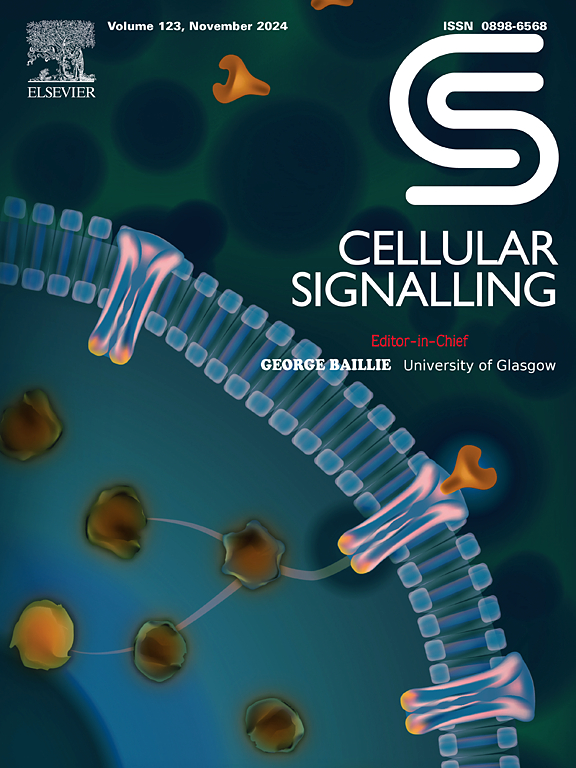USP7通过KPNA2/ klr轴促进骨肉瘤的恶性进展
IF 4.4
2区 生物学
Q2 CELL BIOLOGY
引用次数: 0
摘要
骨肉瘤是一种常见的原发性骨恶性肿瘤,由于其高转移性和对化疗的耐药性,在临床治疗中面临着重大挑战。核胶蛋白亚基α 2 (KPNA2)是核胶蛋白家族的一员,参与多种细胞过程的调控。然而,KPNA2在骨肉瘤发生和发展中的作用尚不清楚。方法采用定量逆转录-聚合酶链式反应(qRT-PCR)检测各组大鼠KPNA2和丙酮酸激酶L/R (pkr) mRNA的表达水平。western blotting检测KPNA2、泛素特异性肽酶7 (USP7)和pkr蛋白的表达。细胞活力、增殖、凋亡、侵袭和迁移分别采用CCK-8、EdU、流式细胞术、transwell侵袭和伤口愈合试验进行评估。葡萄糖消耗和乳酸生成用比色法测定。通过共免疫沉淀(Co-IP)和免疫荧光共定位法鉴定了USP7与KPNA2之间的相互作用。通过体内实验验证KPNA2沉默和klr过表达对骨肉瘤细胞生长的影响。采用免疫组化(IHC)检测Ki67和pkr的阳性表达率。结果skpna2在骨肉瘤组织和细胞中表达上调。沉默KPNA2可抑制骨肉瘤细胞的增殖、侵袭、迁移和糖酵解,同时诱导细胞凋亡。USP7通过其去泛素化活性稳定KPNA2, USP7沉默通过调节KPNA2抑制骨肉瘤细胞的恶性表型。此外,KPNA2上调PKLR的表达,PKLR的过表达减轻了KPNA2沉默对体外和体内骨肉瘤细胞恶性进展的影响。结论USP7对KPNA2的去泛素化作用通过提高pkr的表达促进骨肉瘤的恶性进展。本研究强调了靶向KPNA2-USP7-PKLR轴作为治疗骨肉瘤的潜在治疗策略的临床意义。本文章由计算机程序翻译,如有差异,请以英文原文为准。

USP7 promotes the malignant progression of osteosarcoma through the KPNA2/PKLR axis
Background
Osteosarcoma, a common primary bone malignancy, poses significant challenges in clinical treatment due to its high metastatic potential and resistance to chemotherapy. The karyopherin subunit alpha 2 (KPNA2) is a member of the karyopherin family and has been implicated in the regulation of various cellular processes. However, the role of KPNA2 in osteosarcoma development and progression remains unclear.
Methods
The expression levels of KPNA2 and pyruvate kinase L/R (PKLR) mRNA were assessed using quantitative reverse transcription-polymerase chain reaction (qRT-PCR). Protein expression of KPNA2, ubiquitin-specific peptidase 7 (USP7), and PKLR was determined via western blotting. Cell viability, proliferation, apoptosis, invasion, and migration were evaluated using CCK-8, EdU, flow cytometry, transwell invasion, and wound-healing assays, respectively. Glucose consumption and lactate production were measured using colorimetric assays. The interaction between USP7 and KPNA2 was identified through co-immunoprecipitation (Co-IP) and immunofluorescence co-localization assays. In vivo experiments were conducted to validate the effects of KPNA2 silencing and PKLR overexpression on osteosarcoma cell growth. The positive expression rates of Ki67 and PKLR were assessed using immunohistochemistry (IHC) assays.
Results
KPNA2 expression was upregulated in osteosarcoma tissues and cells. Silencing KPNA2 suppressed osteosarcoma cell proliferation, invasion, migration, and glycolysis, while inducing apoptosis. USP7 stabilized KPNA2 through its deubiquitinating activity, and USP7 silencing inhibited the malignant phenotypes of osteosarcoma cells by regulating KPNA2. Additionally, KPNA2 upregulated PKLR expression, and overexpression of PKLR mitigated the effects of KPNA2 silencing on the malignant progression of osteosarcoma cells both in vitro and in vivo.
Conclusion
The deubiquitination of KPNA2 by USP7 promoted the malignant progression of osteosarcoma by increasing PKLR expression. This study highlights the clinical significance of targeting the KPNA2-USP7-PKLR axis as a potential therapeutic strategy for the treatment of osteosarcoma.
求助全文
通过发布文献求助,成功后即可免费获取论文全文。
去求助
来源期刊

Cellular signalling
生物-细胞生物学
CiteScore
8.40
自引率
0.00%
发文量
250
审稿时长
27 days
期刊介绍:
Cellular Signalling publishes original research describing fundamental and clinical findings on the mechanisms, actions and structural components of cellular signalling systems in vitro and in vivo.
Cellular Signalling aims at full length research papers defining signalling systems ranging from microorganisms to cells, tissues and higher organisms.
 求助内容:
求助内容: 应助结果提醒方式:
应助结果提醒方式:


